NOW PERMANENT: The City of Suwanee now exhibits a piece of the Berlin Wall as a permanent fixture. Learn how this came about in the top story in Upcoming below.
IN THIS EDITIONTODAY’S FOCUS: Here’s the Story Behind Installation of Bicentennial Quilt at GJAC
EEB PERSPECTIVE: What Did You Look Like When You Were a Babe in Arms?
SPOTLIGHT: Primerica, Inc.
FEEDBACK: Early Americans Had an Abysmal Voter Turnout
UPCOMING: Local Restaurateur Donates Part of Berlin Wall Returns to Suwanee
NOTABLE: Suwanee Has Georgia’s Outstanding Police Chief of the Year
RECOMMENDED: Masterpiece Restaurant in Duluth
GEORGIA TIDBIT: Georgia’s George Stallings Remembered for Guiding “Miracle Braves”
MYSTERY PHOTO: The Clues to Today’s Mystery Photo Are Staring at You!
CALENDAR: Gwinnett Schedules Hazardous Household Waste Recycling
TODAY’S FOCUSHere’s the story behind installation of Bicentennial Quilt at GJAC
By Betty Warbington
Co-president, Gwinnett Historical Society
LAWRENCEVILLE, Ga. | A Bicentennial Quilt is now hanging in the Gwinnett Justice and Administration Center (GJAC).
There’s a story behind this quilt. It was originally created as a special quilt to be given away at the annual Elisha Winn Festival in October, which the Gwinnett Historical Society puts on.
However, Co-President Beverly Paff, says: “It turned out to be something really special, and we decided that we wanted it kept in Gwinnett County on display for years to come. So eventually Gwinnett County purchased it, and it is now hanging at GJAC. It will later hang in the Isaac Adair House and/or other historic Gwinnett County buildings, we hope for many years to come.”
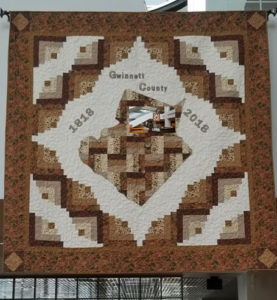 She adds: “So we had to have another quilt made for the festival. Instead, we purchased two lap quilts for the raffle which the Society holds each year at the Winn Festival.
She adds: “So we had to have another quilt made for the festival. Instead, we purchased two lap quilts for the raffle which the Society holds each year at the Winn Festival.
The Bicentennial quilt was designed and pieced by Candy Hardy of Lawrenceville; quilted by Leisa Wiggley of Covington and embroidered by Lynn Hajj of Flowery Branch.
In her research for the creation of this quilt, Ms. Hardy focused on the Georgia Creek Indians. The colors used throughout this quilt were selected to represent various aspects of their lives on this land.
Fabrics chosen by Ms. Hardy were based off of the border fabric called Harvest Hill, as the Creek Indians were harvesters and gatherers. She chose other fabrics with tan and brown tones to also represent the importance of deer hunting and hide tanning.
To represent the hut structures Creek Indians lived in, the outer blocks are a variation of a log cabin quilt block called curvy log blocks. They are placed around the outer edges to also demonstrate their “town square” style of hut arrangement.
Bead working was integral to Creek Indian culture. Therefore, the corners of the quilt are a “square in a square” block set on point to represent a diamond pattern of beading.
Gwinnett County is at the center of the quilt with buttons representing all 16 cities. Lawrenceville, the county seat, has the largest button. All the buttons are a playful reference to the namesake of the county as well – Button Gwinnett!
This quilt will be on display at the historic Isaac Adair House after December 15, 2018.
To be a participant in the raffle for the two quilts at the Elisha Winn Festival, contact the Gwinnett Historical Society office before the October 7 drawing. Participants do not have to be present to win.
- Have a comment? Send to: elliott@brack.net
What did you look like when you were a babe in arms?
By Elliott Brack
Editor and publisher, GwinnettForum
AUG. 3, 2018 | Ever think of yourself as a baby, and what you looked like?
After thinking about this for years, I have concluded that I must have been at least a goofy, if not ugly, baby. That’s hard for me to admit, but I have some evidence to support that idea.
Some of my earliest recollections as a young child were people oogling over me. There were always a lot of aunts and uncles and cousins and other more distant family members, or even non-related adults, around. And they said to my mother over and over the same thing one after the other that I recall when I was maybe two or three years old. This is about as far back as I can remember, and the words were always similar.
“Oh, doesn’t he have the most beautiful brown eyes.”
All I remember of people inspecting me was “brown eyes, brown eyes, brown eyes.”
So from the beginning, naturally I was somewhat proud of my brown eyes. Looking at them today, they don’t seem all that distinctive, though they remain brown.
But I think there was something more going on.
Perhaps they were trying to go easy on my parents. These baby inspectors didn’t want to say to my mother: “But he does look a little different…..(or goofy….or even ugly).” They didn’t want to hurt her feelings, so they all concentrated over and over on those brown eyes.
But how about my ears? They never mentioned that. And yes, I have heard people talk about a baby’s ears. “Doesn’t he have big ears?” is one comment, or another I can recall: “His ears do fit close to his head, don’t they?”
But nothing about my ears. I guess you would call them regular ears.
Other comments about other babies over the years I have heard went in other directions.
“Why look at that sweet smile!” Or “You can’t get a bigger smile than that one,” with sometimes an addition: “And he just continues to smile.”
Or this one: “He (or she) looks like a contented baby.” Of course, that makes the mother beam with pride.
There’s another area where people would compliment a mother about her baby. They would say nothing to a young mother that would reflect problems with a baby in normal social circumstances. And they feel they must say something about this relatively new person. And you know every new mother wants people noticing her baby, of whom she is so proud. So they have to think of a compliment of some sort.
“He sure seems healthy, and look at that smooth skin.”
Or: “He’s a mighty fine baby, not giving you a bit of trouble, not crying nor fretting nor causing trouble.”
Makes me wonder if I was fretful, or difficult. I might have been, but if so, all anyone mentioned were those “beautiful brown eyes.”
Next time you run across a mother with a new baby, of course, you will try to compliment her and her child. At least talk about more than one quality you see in the new babe. For me, that continuous talking about my brown eyes got old quickly.
(Wink).
- Have a comment? Send to: elliott@brack.net
Primerica, Inc.
 The public spiritedness of our sponsors allows us to bring GwinnettForum.com to you at no cost to readers. Primerica, Inc., headquartered in Duluth, is a leading distributor of financial products to middle-income families in North America and is Gwinnett’s fourth largest employer, with 1,700 employees. Primerica representatives educate their Main Street clients about how to better prepare for a more secure financial future by assessing their needs and providing appropriate solutions through term life insurance, which it underwrites, and mutual funds, annuities and other financial products, which it distributes primarily on behalf of third parties. In addition, Primerica provides an entrepreneurial full or part-time business opportunity for individuals seeking to earn income by distributing the company’s financial products. It insures approximately 5 million lives and had over 2 million client investment accounts at December 31, 2017. Primerica is a member of the S&P MidCap 400 and the Russell 2000 stock indices and is traded on The New York Stock Exchange under the symbol “PRI.”
The public spiritedness of our sponsors allows us to bring GwinnettForum.com to you at no cost to readers. Primerica, Inc., headquartered in Duluth, is a leading distributor of financial products to middle-income families in North America and is Gwinnett’s fourth largest employer, with 1,700 employees. Primerica representatives educate their Main Street clients about how to better prepare for a more secure financial future by assessing their needs and providing appropriate solutions through term life insurance, which it underwrites, and mutual funds, annuities and other financial products, which it distributes primarily on behalf of third parties. In addition, Primerica provides an entrepreneurial full or part-time business opportunity for individuals seeking to earn income by distributing the company’s financial products. It insures approximately 5 million lives and had over 2 million client investment accounts at December 31, 2017. Primerica is a member of the S&P MidCap 400 and the Russell 2000 stock indices and is traded on The New York Stock Exchange under the symbol “PRI.”
- For more information, visitprimerica.com.
- For a list of other sponsors of this forum, click here.
In earlier days, really few new Americans exercised the vote
Editor, the Forum:
![]() While I agree that the turnout in the recent runoff was abysmal, I lost a runoff election by just over 600 votes. I don’t think it is possible to compare it to what our forefathers intended, “Such a poor voting turnout is not the type of elections that our Founding Fathers anticipated. Such apathy at the polling place speaks badly of democracy.”
While I agree that the turnout in the recent runoff was abysmal, I lost a runoff election by just over 600 votes. I don’t think it is possible to compare it to what our forefathers intended, “Such a poor voting turnout is not the type of elections that our Founding Fathers anticipated. Such apathy at the polling place speaks badly of democracy.”
In today’s world virtually any citizen can vote if they are of age and registered. This produces the large numbers in your article, that and the population growth over 200+ years. In the world of our forefathers it was much different.
In the election of 1789, the first election of Congress, the overall number of people who were allowed to, and actually voted, was miniscule in state after state. Women and slaves were counted, but not allowed to vote. For example, Delaware had a total state population of just over 59,000, but only 2,059 ballots were cast, meaning just three percent of the population. Georgia’s turnout was around five percent, New York about three percent and Rhode Island has what seems to have been lowest turnout of all, at a lowly 0.7 percent.
So while our numbers are tribally low the hypothetical 10 percent, it is quite a change since 1789. Back then not only did one need to be male and white, one also had to be a landowner.
— Tim Sullivan, Buford
Two readers check in on quotation from President Truman
Editor, The Forum:
Re: “The Buck Stops Here”: Perhaps the meaning of the quote has been modernized, since Truman’s day, by the new regime in charge of making decisions for the country.
The meaning could be stopping at a desk before evolving into (maybe) rubles, for payment of services rendered. It could mean receivables for favors, grants, or information, before transfer to foreign accounts.
Since no one is held accountable, anything can happen, as we are already experiencing.
Seems like everyone has an Achilles heel, but some might be complete heels! Make your vote count!
— Betty Ritcey, Peachtree Corners
Editor, the Forum:
Let me suggest your letter writer who referred to President Truman, read the book The Accidental President, a historical account detailing Truman’s first four months in office after FDR’s death. It may give him a better appreciation of this remarkable man.
— Billy Chism, Toccoa
Dear Billy: Yes, I agree. One of the most engaging and best books I have read on the presidency is David McCullough’s “Truman.” –eeb
Send us your thoughts: We encourage you to send us your letters and thoughts on issues raised in GwinnettForum. Please limit comments to 300 words. We reserve the right to edit for clarity and length. Send feedback and letters to: elliott@brack.net
UPCOMINGLocal restaurateur donates part of Berlin Wall returns to Suwanee
An authenticated piece of the Berlin Wall that once separated West Berlin and East Germany has returned to Suwanee Town Center for good.
 The 12-foot-tall, 7,000 pound section of the wall was donated to the city by Suwanee’s Friends American Grill proprietors Ray Stanjevich and Suzanne Cartwright, who purchased the piece in 2013 at an auction on the Town Center Stage.
The 12-foot-tall, 7,000 pound section of the wall was donated to the city by Suwanee’s Friends American Grill proprietors Ray Stanjevich and Suzanne Cartwright, who purchased the piece in 2013 at an auction on the Town Center Stage.
Stanjevich, a Serbian immigrant, says: “I was born in a communist country, and Suzanne’s mother immigrated from Germany after World War II. We think it’s important to remember the past and not forget that many still live without the basic freedoms that we enjoy in the United States.”
Stanjevich displayed the piece outside of his Suwanee restaurant, and recently decided to donate it to the city as a public art piece. The Suwanee City Council voted at their June meeting to accept the relic, and it is now on display in Town Center Park.
Suwanee’s Assistant City Manager Denise Brinson says: “We’re thrilled to be able to exhibit this section of the Berlin Wall. It’s a cool way to bring an important piece of art and history to area residents. This display fits in well with Suwanee’s goal of making art accessible.”
The wall section spent several months on display in front of Suwanee City Hall and the Gwinnett Justice and Administration Center in 2013 while awaiting auction after it was seized by federal officials to provide some restitution for victims of a Ponzi scheme.
Originally discovered in an East Berlin work camp, the once-western-facing now section features graffiti depicting an American flag, a silhouetted figure, and three buildings. The side that once faced East Berlin is mostly devoid of graffiti. The wall piece has a certificate of authenticity after tests on the concrete and rebar confirmed its materials consistent with those used in Germany in the early 1960s.
Snellville mulling idea of increasing elected officials’ salaries
Snellville is currently weighing a proposal that would raise the future salaries of the mayor and council members for the first time since 1983. Current council members would not get the raise unless they were re-elected.
Under the proposed ordinance, the mayor’s salary would increase from $6,000 to $12,000 and council members’ salaries would rise from $4,000 to $8,000. The mayor pro-tempore would receive $10,000.
The increase in salary, proposed by Councilwoman Cristy Lenski, will not go into effect until after the next election in November of 2019, as mandated by state law. Lenski says an increase in salary will attract better-qualified candidates in future elections.
New Eastside Urgent Care location now open in Grayson
Eastside Urgent Care announces the opening of their new Grayson location at 2594 Loganville Highway, Suite 101. The new Grayson location complements existing Eastside Urgent Care locations in Lawrenceville, Snellville, and Lilburn. Since opening the first location in early 2017, Eastside Urgent Care has provided care to over 25,000 patients throughout the Gwinnett County community. With the addition of their new Grayson location, Eastside Urgent Care now provides more access points than any other urgent care network in Gwinnett County.
NOTABLESuwanee has Georgia’s Outstanding Police Chief of the Year
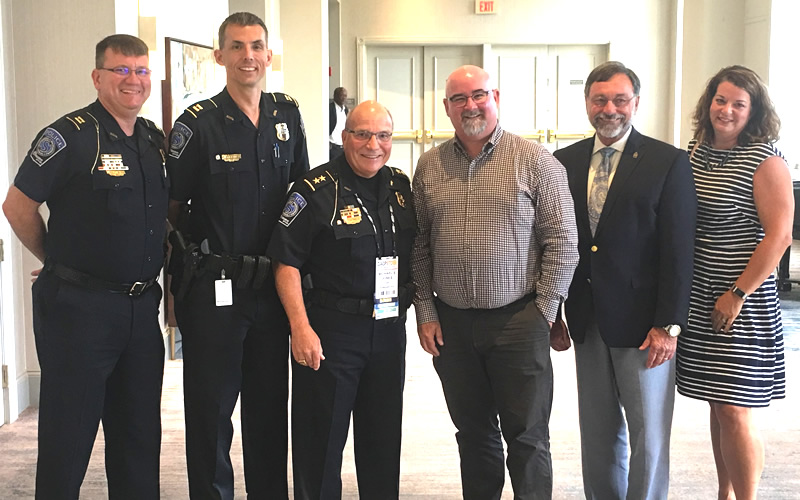
From left are Captain Shane Edmisten, Captain Cass Mooney, Chief Mike Jones, City Manager Marty Allen, Mayor Jimmy Burnette and Suwanee Police Office Administrator Donna Copeletti.
City of Suwanee Police Chief Mike Jones has been named the Outstanding Chief of the Year by the Georgia Association of Chiefs of Police at its recent meeting in Savannah.
Chief Jones began his career in law enforcement as a dispatcher with the City of Rome Police Department in 1974. He became chief of police in the City of Suwanee on January 1, 1999.
During his tenure as Chief of Police, the Suwanee Police Department has more than doubled in size. The department became accredited in 2010 – one of just 56 in Georgia – and was reaccredited in 2013 and in 2016 with Excellence
A leader throughout the state, Chief Jones was elected to serve as vice president of the GACP in 2005 and served as president of the association from 2008-2009. Chief Jones is a proponent of the community policing philosophy and emphasizes the importance of positive relationships with the community he proudly serves. He established a P.A.C.T. (Police And Citizens Together) program in 2001 as a tool used to build trust within the community and to enhance its community watch program.
In addition to the successful residential P.A.C.T. program, the department hosts a Citizens Police Academy twice a year, has an active Explorers program, utilizes citizen volunteers in the Park Ambassador program, and staffs C.O.P.S. (Caring Officers Providing Support) in the local elementary schools. Most recently, Chief Jones has begun working closely with the Korean-American Council, a group of Korean-American business owners and stakeholders to build bridges between the Korean community and the police.
Georgia PCOM campus graduates first class of physician assistants
 The inaugural class of 19 members of physician assistant (PA) studies students of Georgia Campus – Philadelphia College of Osteopathic Medicine (GA-PCOM) graduated from the Infinite Energy Forum on July 31.
The inaugural class of 19 members of physician assistant (PA) studies students of Georgia Campus – Philadelphia College of Osteopathic Medicine (GA-PCOM) graduated from the Infinite Energy Forum on July 31.
Brian Maloney, MD, FACS, an educator, internationally recognized facial plastic surgeon, and founder of The Maloney Center for Facial Plastic Surgery in Atlanta, delivered the commencement address. He also contributes to the GA-PCOM program by serving as a clinical lecturer. His daughter, Meghan Maloney, is a 2016 physician assistant graduate who received her degree from the Philadelphia campus.
The 19 graduates join the ranks of PCOM’s nearly 1,000 physician assistant alumni who practice across the nation. This year, the incoming class size in Georgia was increased to 26 physician assistant studies students.
Begun in Georgia in 2016, the 26-month physician assistant studies program consists of 14 months of classroom instruction followed by 12 months of clinical rotations in multiple medical disciplines. The PA program has received Accreditation-Continued status by the Accreditation Review Commission on Education for the Physician Assistant.
City of Suwanee recognized for superior data-driven reporting
The City of Suwanee has once again been recognized by the International City/County Management Association (ICMA) for superior data-driven management and reporting efforts with a Certificate of Distinction. Suwanee is among 13 jurisdictions receiving the Certificate of Distinction, and one of 57 recognized overall. This is the ninth year that Suwanee has been recognized for its accomplishments since the certificates were first awarded in 2002.
Certificates of Distinction are awarded to those who also provide comparative and benchmarking information to the public, use performance data in strategic planning and operational decision-making, and share their knowledge with other local governments through presentations, site visits, and other networking activities.
RECOMMENDEDMasterpiece Restaurant in Duluth
![]() It’s getting rave reviews from food critics all over Metro Atlanta, so we visited Masterpiece Restaurant, on Buford Highway near North Berkeley Lake Road. If you want tasty Szechuan food, you should visit at 3940 Buford Highway. What we liked best was the tasteful flavor of the offerings, from a delicious fish soup flavored with cilantro to the zesty and slightly tangy Hot and Sour Soup, to the Garlic Shrimp and pot stickers. We didn’t try any offering with several ‘hot marks’ by their names. Two of those markers were enough for us. The restaurant also has a long vegetarian menu. The night we were there it served basically an Asian clientele. Though only open a short time, one reviewer calls it among the best restaurants in the South. Chef Rui Liu been nominated as a semifinalist in the James Beard best chefs awards.–eeb
It’s getting rave reviews from food critics all over Metro Atlanta, so we visited Masterpiece Restaurant, on Buford Highway near North Berkeley Lake Road. If you want tasty Szechuan food, you should visit at 3940 Buford Highway. What we liked best was the tasteful flavor of the offerings, from a delicious fish soup flavored with cilantro to the zesty and slightly tangy Hot and Sour Soup, to the Garlic Shrimp and pot stickers. We didn’t try any offering with several ‘hot marks’ by their names. Two of those markers were enough for us. The restaurant also has a long vegetarian menu. The night we were there it served basically an Asian clientele. Though only open a short time, one reviewer calls it among the best restaurants in the South. Chef Rui Liu been nominated as a semifinalist in the James Beard best chefs awards.–eeb
An invitation: what books, restaurants, movies or web sites have you enjoyed recently? Send us your recent selection, along with a short paragraph (100 words) as to why you liked this, plus what you plan to visit or read next. Send to: elliott@brack.net
GEORGIA ENCYCLOPEDIA TIDBITGeorgia’s Stallings remembered for guiding “Miracle Braves”
George Stallings, known to baseball fans as the “Miracle Man,” managed one of the most renowned teams in the game’s history, the 1914 “Miracle” Boston Braves. Trailing the first-place New York Giants by 11.5 games on July 15, the Braves mounted an unprecedented rally, winning 61 of their final 81 games to capture the National League pennant by 10.5 games.
George Tweedy Stallings was born to Eliza Jane Hooper and William Henry Stallings in Richmond County, near Augusta, on November 17, 1867. He began his baseball career as a student at Richmond Academy. Primarily a catcher, Stallings later played on various minor league teams before appearing briefly in the major leagues, with the Brooklyn Bridegrooms, in 1890.
Demoted to the minors, he enjoyed success as a manager. In 1897 Stallings returned to the majors, serving as manager of the National League’s Philadelphia Phillies for parts of two seasons. Over the next decade he managed several minor league and major league teams, including the American League’s Detroit Tigers and New York Highlanders (later the New York Yankees).
In 1913 Stallings assumed the helm of the team that would bring him fame, the Boston Braves. Fifth-place finishers in 1913, the Braves appeared to be headed for another lackluster season in 1914, occupying last place in mid-July. Under Stallings’s guidance the Braves reversed their momentum, racing to first place in fewer than 40 days.
Climaxing their remarkable comeback, the Braves swept the Philadelphia Athletics, considered invincible, in the World Series. Stallings continued managing the Boston team until his retirement at the end of the 1920 season, but he never again enjoyed the success of 1914. He finished his career with 879 victories in 1,813 major league games. He later came out of retirement as an owner and manager in the minors.
Stallings was notorious for his temper and superstitions. He ranted at players if they left trash behind in dugouts. Yellow signs and yellow clothing annoyed him; yellow ballpark advertisements had to be painted over before he would let his team play. He refused to talk to rookies until they had played one week, insisting that his silence tested their courage. If he was in a particular physical position, no matter how uncomfortable, when the Braves began a rally, he remained in that position until the rally ended. When asked after the 1914 World Series why the Braves won, he replied that it was because of a “lucky penny.” He also attributed the team’s success to a “lucky dime” that had been blessed by a priest in Cuba.
For more than 30 years Stallings lived on a plantation in Haddock, in Jones County. He took his teams there for part of spring training each year. He died in Haddock on May 13, 1929, and was buried in Macon. At the time of his death, he was owner of the Montreal Royals of the International League. Stallings was inducted into the Georgia Sports Hall of Fame in 1979. He married more than once and had three sons, White, Vernon, and George Jr.
- To view the Georgia Encyclopedia online, go to http://www.georgiaencyclopedia.org
The clues to today’s Mystery Photo are staring at you!
Can you spot the several clues in today’s Mystery Photo. They are right there looking at you. Figure out where this is, and send your answer to elliott@brack.net, including your hometown.
 What we thought was a cream puff Mystery Photo drew little responses. First in was Jim Savadelis of Duluth, who told us: “This is the infamous Eagles Nest in Berchtesgaden, Bavaria, Germany. Hitler was its notorious inhabitant.” The photo was submitted by Pearl Sharp of Lawrenceville after a recent visit in Germany.
What we thought was a cream puff Mystery Photo drew little responses. First in was Jim Savadelis of Duluth, who told us: “This is the infamous Eagles Nest in Berchtesgaden, Bavaria, Germany. Hitler was its notorious inhabitant.” The photo was submitted by Pearl Sharp of Lawrenceville after a recent visit in Germany.
Bob Foreman of Grayson chimed in with: “The photo today is the Eagles Nest, or Kehlsteinhaus, built in the mountains above the town of Berchtesgaden, Germany. It was built by the Nazi Party in 1938 and was used by Hitler before and during the Second World War. Today it is a restaurant.” Others recognizing the photo include Brenda Kennedy of Lawrenceville; Ross Lenhart of Pawley’s Island, S.C.; Rick and Sandy Krause, Lilburn; Susan McBrayer of Sugar Hill; and George Graf of Palmyra, Va.
Allan Peel, San Antonio, Tex. wrote: “Today’s mystery photo is of the Kehlsteinhaus (known as the Eagle’s Nest in English-speaking countries), Adolf Hitler’s mountaintop chalet and the former southern headquarters of the Nazi party. Perched atop Mt. Kehlstein, Eagle’s Nest offers a dark history and panoramic views of Germany’s Bavarian Alps. At the chalet, visitors can explore almost-untouched rooms, visit underground bunkers, and dine at the site’s cozy panoramic restaurant and beer garden.
“A Third Reich-era building, the chalet was commissioned by Martin Bormann in the summer of 1937. Paid for by the Nazi Party, it was completed in 13 months. A 13 foot wide approach road climbs 2,600 feet over 4.0 miles and includes five tunnels and one hairpin turn. The road has been closed to private vehicles since 1952 because it is too dangerous and steep for regular vehicles. The house can be reached on foot (in two hours) from the town of Obersalzberg, or by one of the shuttle buses which have special modifications to take on a slight angle as it climbs the hill.
“An alternative way to reach the chalet is in an opulent elevator decorated with brass, leather, and Venetian glass rising 407 feet from the car park through solid rock to the summit. Hitler did not trust the elevator, continually expressed his reservations of its safety, and disliked using it. His biggest fear was that the elevator’s winch mechanism on the roof would attract a lightning strike, which actually occurred twice during its construction. Oh my, if only Hitler had used the elevator more often, perhaps WWII would have ended much sooner!”
CALENDAR![]() FOURTH ANNUAL DUCK DERBY will be Saturday, August 4 at 3 p.m. at West Gwinnett Park Aquatic Center. Sponsored by the Rotary Club of Sugarloaf, it will include an afternoon of free pool time. Two food vendors will be on hand, Habanero Grill Food Truck and Snowie Days Shaved Ice. For more info, and to adopt ducks, visit www.GwinnettDuckDerby.com.
FOURTH ANNUAL DUCK DERBY will be Saturday, August 4 at 3 p.m. at West Gwinnett Park Aquatic Center. Sponsored by the Rotary Club of Sugarloaf, it will include an afternoon of free pool time. Two food vendors will be on hand, Habanero Grill Food Truck and Snowie Days Shaved Ice. For more info, and to adopt ducks, visit www.GwinnettDuckDerby.com.
LILBURN’S NINTH ANNUAL National Night Out is Tuesday, August 7, from 6 to 8:30 p.m. at Plaza Las Americas, 733 Pleasant Hill Road. Sponsored by the Lilburn Police Department, it will feature exhibitions and 40 participating vendors. The Georgia Law Enforcement Moving Memorial will be on display at the event.
SEPTIC TANK MAINTENANCE workshop will be on August 9 at 1 p.m. at the Five Forks Branch of the Gwinnett Public Library, 2780 Five Forks Road. Participants may qualify for a five percent Stormwater Utility Fee credit.
AUTHOR VISIT: Julie Hedgepeth Williams is an award winning journalism professor at Samford University in Birmingham, Ala. She will speak at Liberty Books, 176 West Crogan Street in Lawrenceville, on August 9 at 7 p.m. under the auspices of the Gwinnett County Public Library. She is the author of the 2014 Ella Dickey Literacy Award winner, A Rare Titanic Family, and Wings of Opportunity: The Wright Brothers in Montgomery, Alabama 1910. Her latest book, Three Not-So-Ordinary Joes, traces an extraordinary tale that focuses on the curious intersection of the lives of Joseph Addison, Joseph Addison (J.A.) Turner, and Joel Chandler Harris, and the circumstances leading to the publication of Harris’ Uncle Remus stories.
LUNCH AND LEARN about the history of the Atlanta Braves on Friday, August 10 at noon at the Georgia Archives in Morrow. Carolyn Serra, of the Braves staff, will talk of the heritage of the team and its Hall of Fame members. Lunch and learn programs are free and sponsored by the Friends of the Georgia Archives. No advanced registration is required.
HOUSEHOLD HAZARDOUS WASTE recycling will be held August 11 from 9 a.m. until noon at the Department of Water Resources Central Facility at 684 Winder Highway in Lawrenceville. Gwinnett residents can drop off five containers each of household hazardous waste for free. The event is limited to Gwinnett residents and proof of residency may be required. Materials accepted at the event include cleaners, batteries, fluorescent light bulbs and ballasts, lawn care products, oils, paints, and pesticides.
GROUNDBREAKING at Graves Park Expansion, 1540 Graves Road, Norcross, will be Tuesday, August 14, at 9:30 a.m. Directions: From I-85 at Jimmy Carter Boulevard, go east to McDonough Drive, turn south until dead end. Turn left on Graves Road. Park is on the right.
OUR TEAMMeet our team
- Editor and publisher: Elliott Brack, 770-840-1003
- Managing editor: Betsy Brack
- Roving photographer: Frank Sharp
- Contributing cartoonist: Bill McLemore
- Contributing columnist: Jack Bernard
- Contributing columnist: Debra Houston
- Contributing columnist: George Wilson
More
- Location: We are located in Suite 225, 40 Technology Park, Peachtree Corners, Ga. 30092.
- Work with us: If you would like to serve as an underwriter, click here to learn more.
Subscriptions to GwinnettForum are free.
- Click to subscribe.
- We hope you’ll keep receiving the great news and information from GwinnettForum, but if you need to unsubscribe, go to this page and unsubscribe in the appropriate box.
© 2018, Gwinnett Forum.com. Gwinnett Forum is an online community commentary for exploring pragmatic and sensible social, political and economic approaches to improve life in Gwinnett County, Ga. USA.



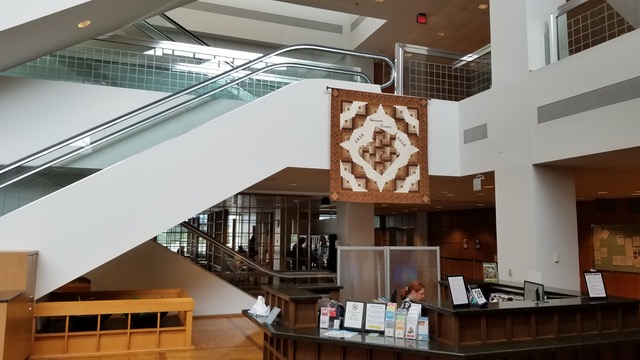


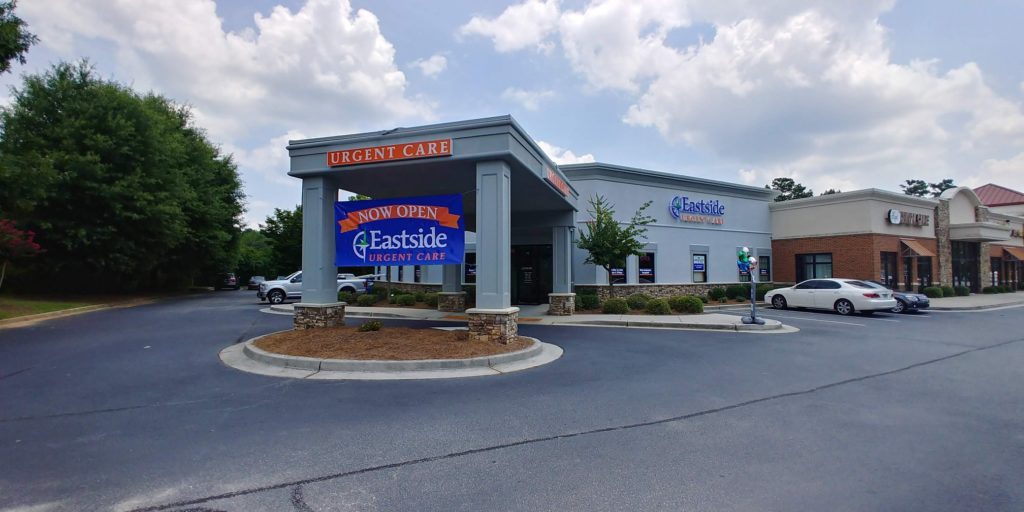
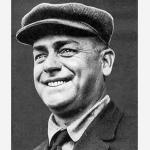









Follow Us